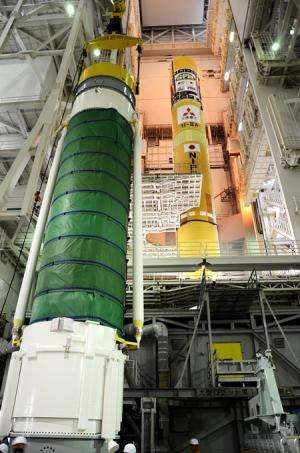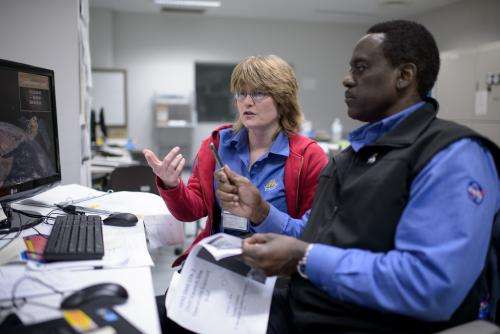Home stretch for GPM engineering team in Japan

The Global Precipitation Measurement (GPM) Core Observatory is set to launch from Tanegashima Space Center in Japan on Feb. 27 at 1:37 p.m. EST. It's the home stretch for the GPM engineering team from NASA's Goddard Space Flight Center, Greenbelt, Md., that has been on site at Tanegashima preparing for launch for the past four months.
"About 200 people working on GPM came to Tanegashima at one point or another," said Kelly Catlett, the GPM project's support team lead.
A rolling staff began arriving just before the spacecraft arrived in Japan on Nov. 24, 2013. Since then people have come for several weeks, most in December for the Core Observatory post-shipping performance tests, then returned home, some to return in January or February. Catlett and her team, including Suja Lee, GPM's interpreter, were in charge of making sure everyone had a place to stay, transportation, and a badge for the space center.
Some GPMer's have been living on Tanegashima for the entire stint, with just short breaks to return home. Collectively they know the restaurants in Minamitane and all the spots to go in Tanegashima—it's not a big island, smaller than NASA's Kennedy Space Center.
The GPM team's base of operations is the third floor of the Spacecraft Test and Assembly building, or STA-2: a couple conference rooms, two big bull-pen offices with rows of desks, and a collection of storage rooms. Catlett and her support staff are always on-call, helping with IT problems, handling logistics and spacecraft documentation, keeping the daily schedule of spacecraft activities, and a dozen other day-to-day details to keep the team running.
Downstairs on the first floor is where the action happens. Safety reminders and shelves of steel-toed shoes sit outside doors headed for the clean room where the Core Observatory was inspected and tested after its arrival. Next door is the support control room, where the team on console here in Tanegashima will monitor the spacecraft during launch. Right now the spacecraft is sitting on top of the H-IIA rocket in the Vehicle Assembly Building near the launch pad.
The rocket arrived on Jan. 20, and the GPM team was invited to participate in a Shinto blessing ceremony in front of the rocket on Jan. 22. The GPM Instruments' Chief Safety and Mission Assurance Officer, Lynette Marbley, represented the team.
"The ceremony was broken into several sections with the Shinto priest doing a lot of chanting approaching the altar, bowing and shaking a large branch in front of the altar and over his shoulders. The room was very quiet," she said of the ceremony. While the whole GPM team participated in bowing and clapping as a group at certain times, as the NASA representative Marbley's role was to take the offering branch in a specific way and place it on the alter. "I was very nervous," she said. "I have never felt so proud to represent NASA and my country."

A few days after the blessing ceremony on Jan. 25, the GPM team participated in a cultural event at the Samurai House in Nishinomoote, the town at the north end of the island. The event included traditional Japanese music, a tea ceremony, a calligraphy demonstration, and a kimono demonstration, said Warren Schultzaberger, GPM's photographer. He photographs the spacecraft to document issues and progress for the engineers. He took his camera with him to the Samurai House.
"It was so much fun learning about the different parts of Japanese culture," said Shultzaberger.
Mark Fiebig and Caitlin Bacha from the propulsion team were models for the kimono demonstration. A week later, they donned a different set of costumes with the rest of the propulsion team, a suit called a SCAPE suit, which stands for Self-Contained Atmospheric Protective Ensemble to protect them from the toxic hydrazine fuel, the GPM Core Observatory's propellant.
"The process for loading the spacecraft is not quite as easy as going up to the gas pump and driving off in a few minutes with a full tank," wrote Bacha, who will be supporting launch from Goddard. Fueling involves special training to work with hydrazine and several weeks of preparation. One tricky part was remembering you can't scratch your nose in the SCAPE suit.
Overseeing all of the GPM team's activities is the Safety and Mission Assurance team. At every step of each activity, they're there to make sure that both the spacecraft and the team are safe and in good shape.
"My job is to look at the spacecraft design and the processes we use and figure out all the ways they could go wrong, and then implement design or procedural steps to avoid failures," said safety engineer Shirley Dion over dinner one evening a few days before launch. She navigated the Japanese menu with the proprietor like a champ, able to ask what different things were—not always easy, even with some of the dish names written in English—and ordered for the table in complete Japanese sentences. One of the crew who has been in Japan for several months, she took two years of Japanese classes. "Although I can speak and be understood, I still can't read the kanji," she said.
The language barrier has been one of the challenging things to cope with, said Glenn Bock, a test conductor who has been in Japan since November and is the person to ask if you want to see Tanegashima's sights. At the Space Center the Japanese engineers speak English, however most business owners in Minamitane only have a few English words. But, Bock said, for everyday transactions "if they don't know English, you can write it down and they'll be able to understand it, or you point."
The people of Tanegashima have shown the NASA team "omotenashi," or the spirit of Japanese hospitality. "Any time you go out to a restaurant or store, they're very welcoming and helpful," said Andy Aylward, lead engineer for the electrical ground support equipment. Twelve and half hours before launch, he'll be on the launch pad overseeing the power up of the spacecraft before hightailing it back to the control room in STA-2. There he'll join Bock and others on console during launch.
As liftoff draws closer so does the excitement.
"It's been five years and I'm ready to see this thing launch," said test conductor John Pope, who, like many on the team, has been working toward this moment for a long time.
But launch is not the end, Pope added. GPM's mission is just beginning. Pope will be right there in the Goddard Mission Operations Center as the Core Observatory gets underway.
Provided by NASA



















